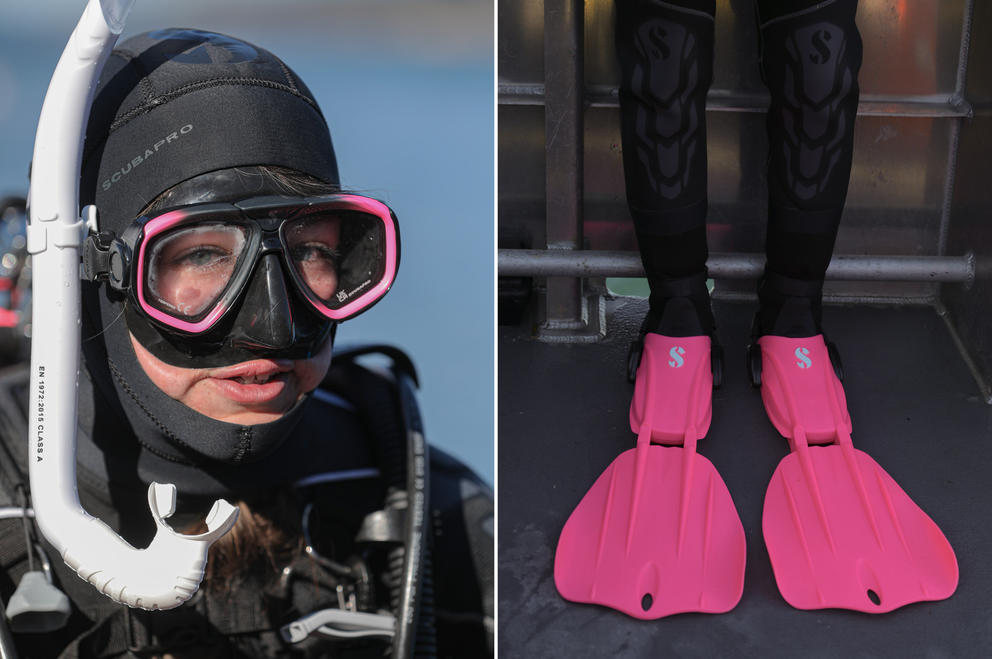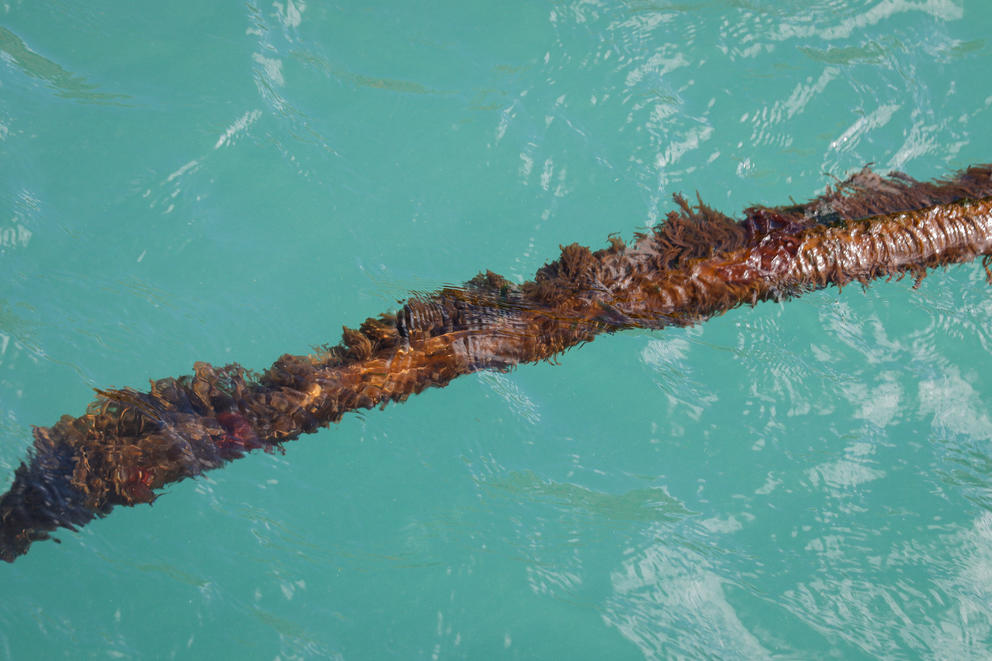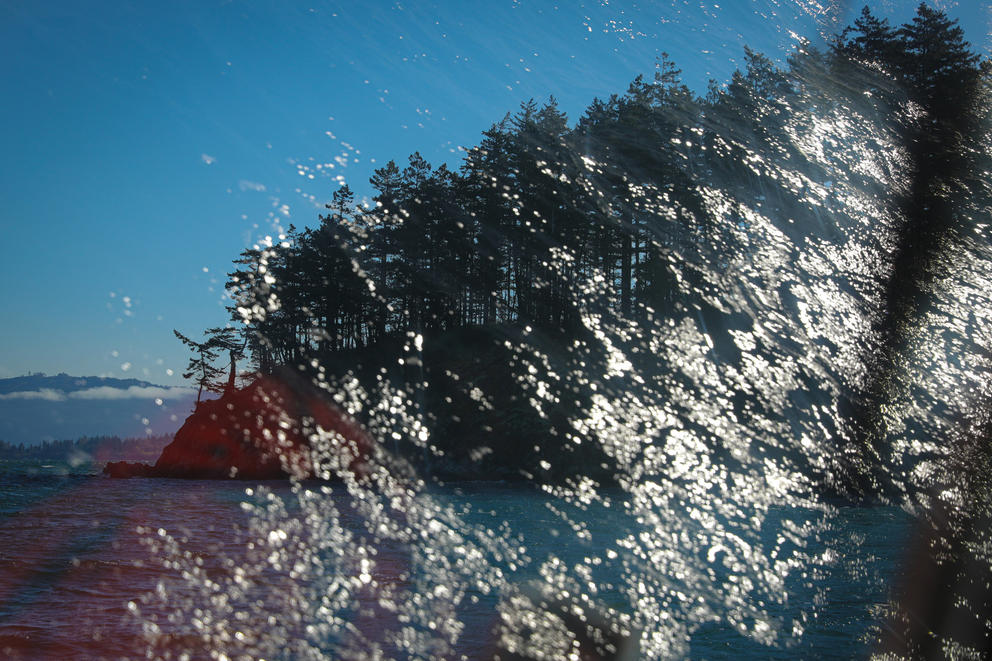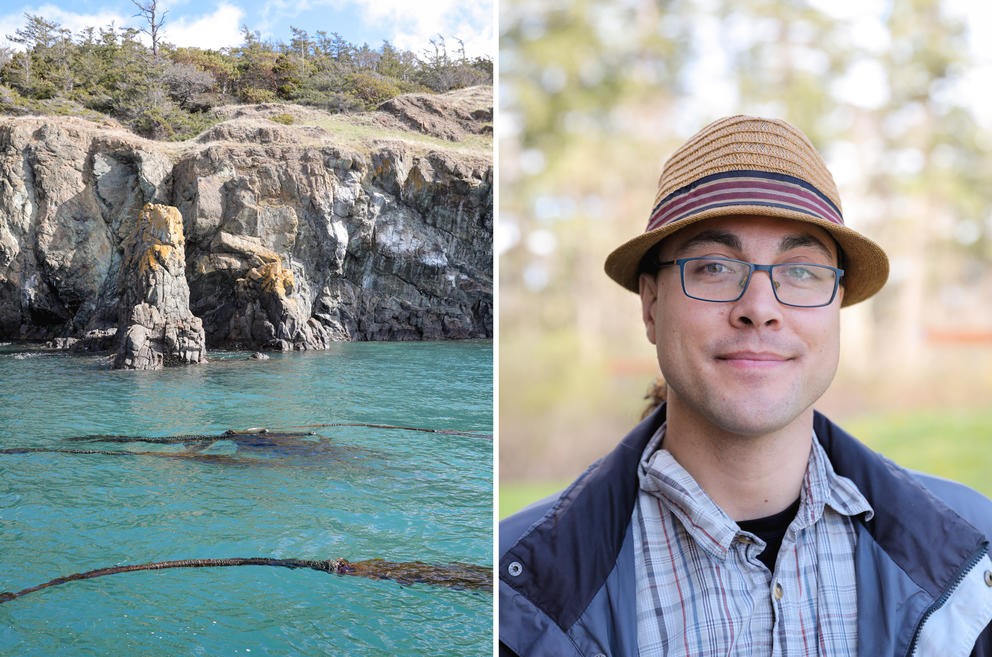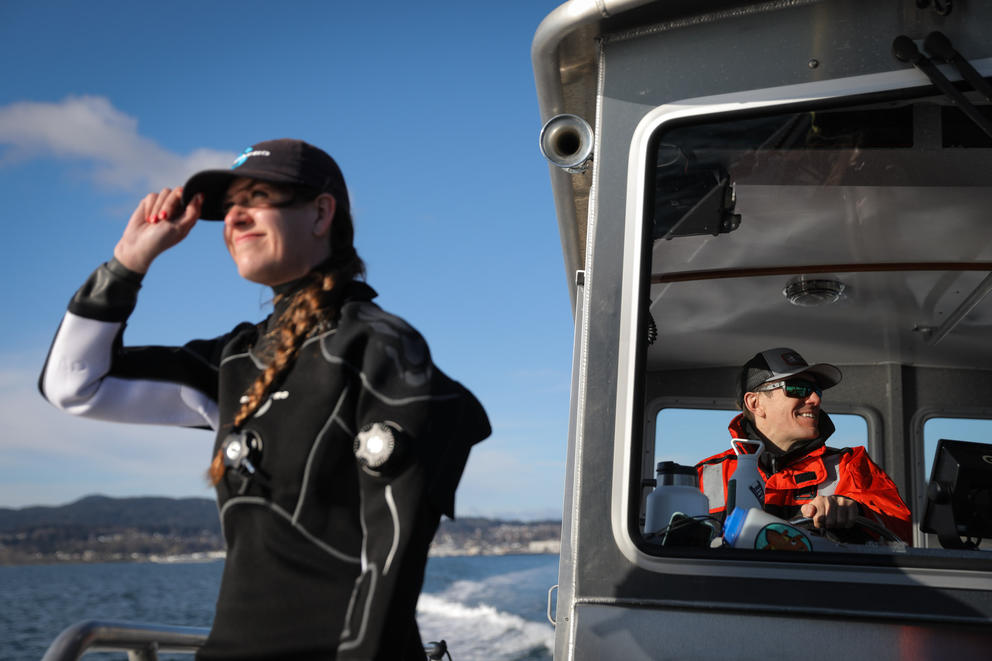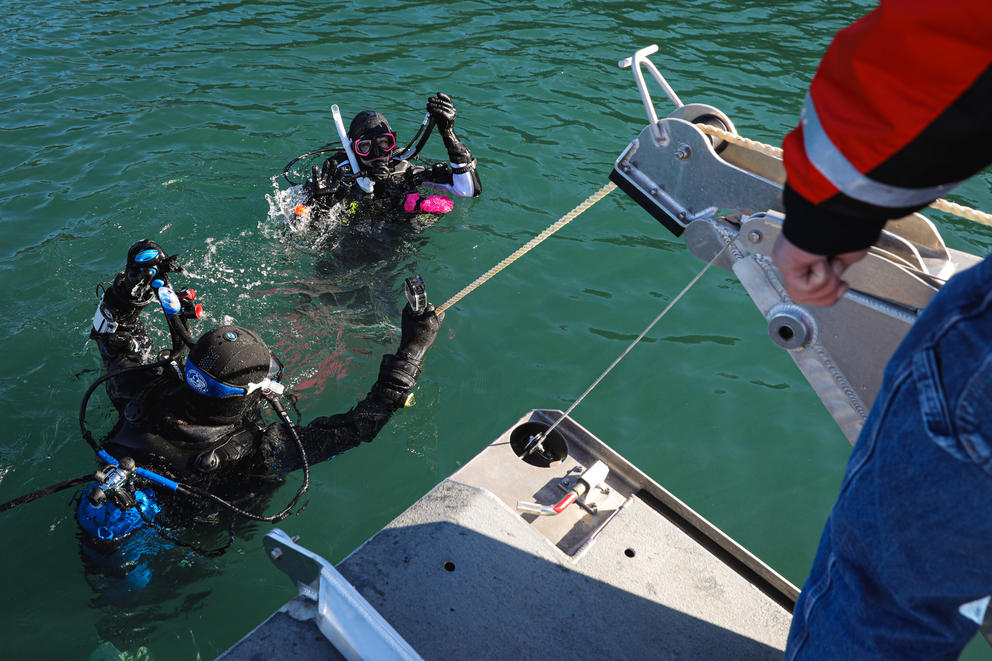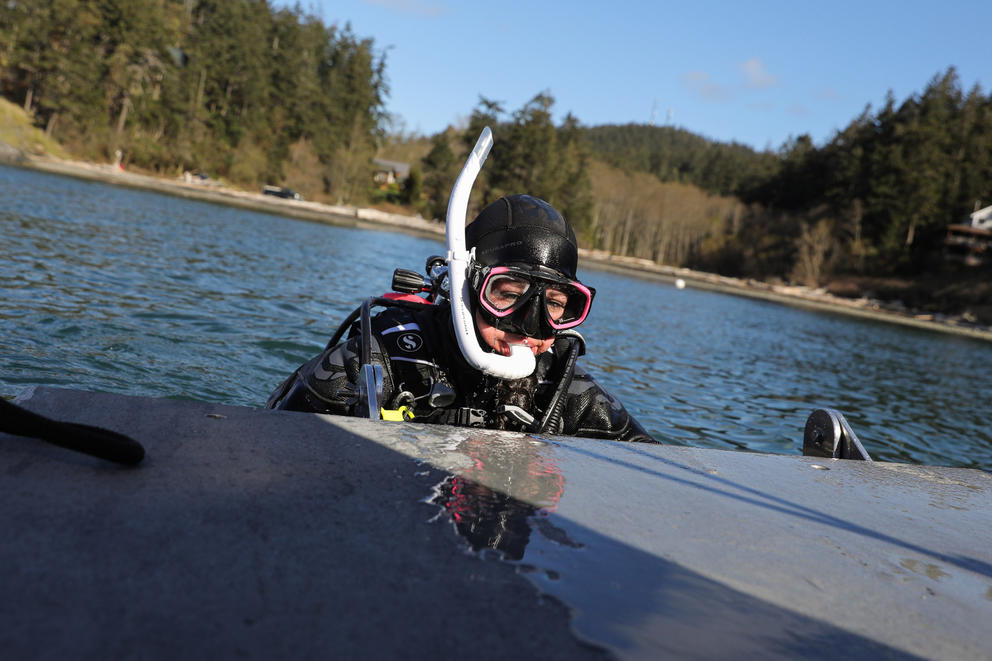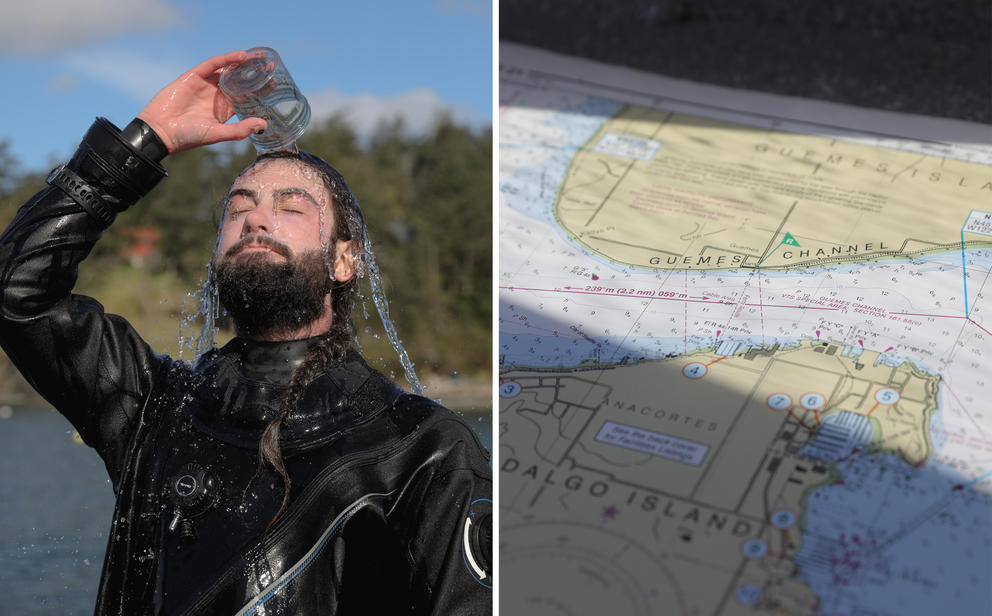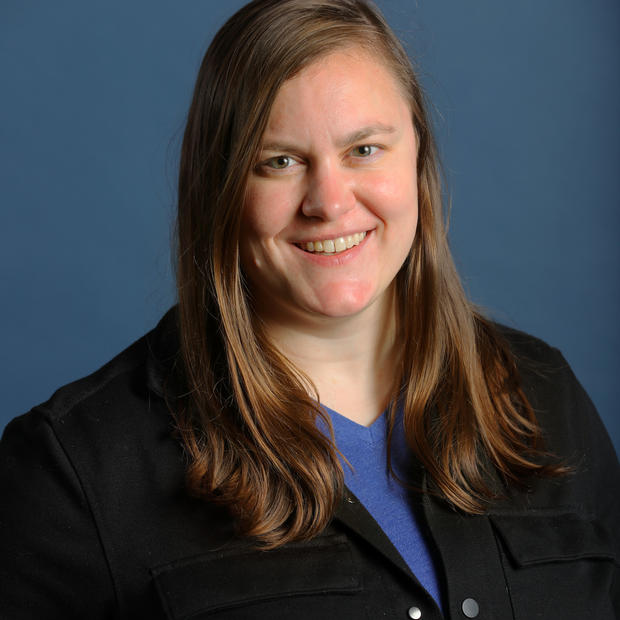They’re heading to the kelp beds near Huckleberry Island, which sits at the center of the Samish Nation’s traditional homelands near Anacortes. After setting a bearing on their compasses to lock in the general location of the kelp sensors, one of the divers back-rolls off the boat into Puget Sound with a splash, her pink flippers plopping into the frigid water (43 to 45 degrees Fahrenheit).
“Then comes the game of ‘Find our needle in the kelp stack!”, said Jennie De La Cruz, a non-Native Samish Department of Natural Resources Technician.
Because biofilm and algae quickly grow over the sensors, finding them can be a little tricky, but once one is found, the divers can bring the sensor to the surface, upload the data it collected, then head back down and reattach it.
Last summer the dive team started Reef Check surveying, which is a new national protocol to assess the health of kelp beds, conducted by highly trained citizen divers. It's repeatable and comparable, so they can get the same data and compare it to data from California and Oregon. According to Todd Woodard, the non-Native Samish Department of Natural Resources’ executive director of infrastructure and resources, there are conversations about collaborative research across the Salish Sea into Canada.
They document the sediment, the fish, the invertebrates and the different species of kelp, and map it all out. The kelp forest near the Burrows Island Lighthouse is fairly large. It took the team of three divers four full days of two dives a day to do the whole survey at that location. The dives gather data not only on the extent of the kelp bed, but also about its health and density.
“It’s really a great protocol by which you can assess the health of a kelp bed and collect data that can be compared throughout the Salish Sea,” Woodard said.
Kelp has long been an important part of the Samish diet and culture. The dive team, formed in 2021, was created to gain a better understanding of the health of the kelp forests after Samish elders noticed they weren’t finding kelp fronds, which are traditionally used to wrap salmon. This triggered the Samish Department of Natural Resources’ involvement.
The round parts of the kelp plant, which fill with a gas so that they float to the surface toward the necessary sunlight, were traditionally used by Samish people for heating and lighting. Samish parents would also dry them out and put rocks in them for their infants’ first rattles, which were enjoyed when passing on songs. Kelp is used as a guide for Samish fishermen because of the known ecosystem within the kelp forests, and has even been a part of the Samish diet in a kelp and herring-egg soup.
“Samish DNR’s mission is to protect, enhance and restore all culturally relevant species and their habitats for current and future generations,” said Woodard. Woodard believes there's little separation between any of the natural resources and their cultural importance. “If the kelp forests go away, there’s a whole host of species that go away, and that’s going to impact humans because a lot of them are utilized by people for foods, whether they be first foods or modern-day. It’s gonna have a bigger impact than people realize.”
Kelp forests are used by thousands of species, including three species of threatened or endangered rockfish, endangered salmon, crabs, sea urchins, sea otters, harbor seals, sea lions, great blue herons and even Puget Sound’s beloved orcas. In addition to providing both nutrients and habitat, kelp forests also combat global climate change. Washington state's kelp forests takes up 27 to 136 metric tons of carbon per day, equivalent to the emissions of 2,000 to 10,500 vehicles per year, according to the 2020 Puget Sound Kelp Conservation and Recovery Plan report.
“They really are the forests under the ocean, and they perform a similar ecological function to the big old-growth forests on land,” Woodard said.
Without the vital food chain and habitat kelp provides, ecologists fear that a decline in all the other life that depends on kelp will follow. They worry in particular about the impact of ocean acidification and coastline erosion without the kelp barrier.
Traditional ecological knowledge
The Samish, who have understood this since time immemorial, are employing a combination of Western science and traditional ecological knowledge in their research efforts. In addition to monitoring the health of kelp beds with aerial photography captured by Pictometry International, Samish DNR Technician Toby McLeod, a Samish citizen, comes from a tribal fishing family, so he interviewed family elders and asked them to recall everything they could about the kelp forests of the past.
McLeod brought a map of the San Juan Islands to his dad’s house, where his uncle was also present, and asked them to show on the map where they remember kelp.
They picked up pens and started drawing on the map indicating where the red, brown and green kelp can be found, where kelp used to be, where the kelp is now. His father also shared generations-old information passed down from his parents or grandparents, giving decades’ worth of information in a single picture.
McLeod was raised by his father, who started fishing professionally at age 11 in 1957. McLeod’s great-grandmother made his father’s first fishing net.
“I grew up basically on the water working in nature and utilizing natural resources,” McLeod said. “I always had this connection with the natural resources and with the area that I grew up in.”
McLeod earned a degree in oceanography at the University of Washington with a minor in marine biology. Some time after he graduated, he secured a job working for the Samish Indian Nation’s natural resources department, then moved into his current position as a field technician.
McLeod believes that growing up as a tribal citizen who continues to benefit from and give back to his environment in a good way has led to his natural progression in the Samish kelp research work.
“Each of our projects at the Department of Natural Resources is guided by tribal citizens and the tribal council,” McLeod said. “We look at our environment holistically. Everything relates to everything else. Everything contributes to everything else.”
In McLeod’s great-grandparents’ generation, all of Padilla Bay, from Huckleberry Island to the twin bridges west of the Swinomish Casino, were covered in kelp. That’s a massive area, which indicates how the landscape has changed.
“The kelp was so thick that when it broke off, it would form little floating islands. During my great-grandparents' generation, they talked about tribal members going out and they would use these islands to park their canoes and they would fish off those islands,” said McLeod, who added that they could stay out there for months at a time.
“If you caught the right current, it could take you to Hawaii in about a month’s time. There’s a historical relationship between Hawaiians and Natives of the Pacific Northwest that tribes still celebrate.”
Difficult data
Now, kelp has declined by 62% around Shaw Island, 72% around Blakely Island, and 77% around Patos Island, according to the Puget Sound Restoration Fund. In just the past 50 years, Puget Sound bull kelp has declined 80%, and bull kelp beds around Bainbridge Island disappeared completely in 2015.
From a microscopic spore, bull kelp grows annually to large narrow blades growing from bulbous floats that form a golden-brown canopy on the water’s surface. These floats are washed away in the fall, which makes them hard to study. There is no definitive answer yet as to why there has been such a dramatic decline in kelp, so the Samish dive team’s work is designed to fill in the data gaps to inform the science of the kelp disappearance as well as its restoration.
Future goals
The Samish diving team has partnered with Shannon Point Marine Center’s scientific program. They provide dive safety oversight while the new Samish dive team develops their program, helping them get certified and guiding the team to institute their own program.
“Our hope is that the Samish Nation will be one of the first Indigenous nation members of the American Academy of Underwater Sciences [AAUS]. You have to have a whole program in place to get accepted.”
Woodard says that being a sovereign nation with its own program has always been a goal — one they hope to accomplish in the next two years, he says.
Of the three-person dive team, De La Cruz is already AAUS-certified and is working toward her divemaster training, which means that when the Samish Nation has its own AAUS-accepted organization, she will be able to function as the team’s dive safety officer. Charlie Donahue, the third Samish DNR Technician on the dive team, and McLeod are close to finishing their training to become AAUS-certified as well. Woodard’s hope is to get everybody divemaster-certified so they can become instructors and the team can continue to grow, bringing on new technicians and certifying Samish people under the same stringent guidelines as the international AAUS — but on their own, as a sovereign nation.
Over the next two years, the dive team will be partnering with the Puget Sound Restoration Fund, which has been growing kelp in a lab. They will be scouting pilot restoration sites in the San Juan Islands. In this next phase, the team will compare sites where kelp has persisted since 2006 to sites nearby where it’s disappeared, and start to investigate and determine the reasons for these differences. Through that process they hope to identify good candidates for pilot restoration sites.
“Mapping and information shows approximately a 30% loss of kelp canopy throughout the San Juans,” Woodard said. “Some specific areas are in the 70% to 80% [range of] loss of canopy area, so we’re really concerned. Climate [change] is a symptom. We don’t necessarily know which particular virus is causing the symptom, so that’s where it gets a little bit tough.”
What can you do?
Since climate scientists are at the leading edge of the research behind why kelp is disappearing, Woodard hopes that people will consider climate change on a broader scale: reduce, reuse, recycle and consider how you’re utilizing fossil fuels that contribute to the warming oceans and the acidification that’s impacting kelp and underwater habitats. Woodard also urges folks to vote pro-environment and pro-climate resilience.
McLeod agreed, adding that the Indigenous cultural value of expressing, feeling and understanding gratitude as a way of interacting with other people, other creatures and the environment is important to the compassionate, caring reciprocity needed for a healthy planet.
“One of my aunts used to tell me that the shortest prayer she knows is the word thanks,” McLeod said. “The Samish are known as the giving people, so there’s generosity, and then the reciprocity is gratitude, and thankfulness. That is just a way to think and move about the world. That’s something that anyone can do that doesn’t require much effort, and by promoting that as a cultural value has a positive effect, even if you might not be able to detect it in terms of specific or quantifiable environmental impact.”
Correction: An earlier version of this story said that Puget Sound kelp forests takes up 27 to 136 metric tons of carbon per day, equivalent to the emissions of 2,000 to 10,500 vehicles per year. The story has been corrected to show that Washington State kelp forests take up 27 to 136 metric tons of carbon per day, equivalent to the emissions of 2,000 to 10,500 vehicles per year.


